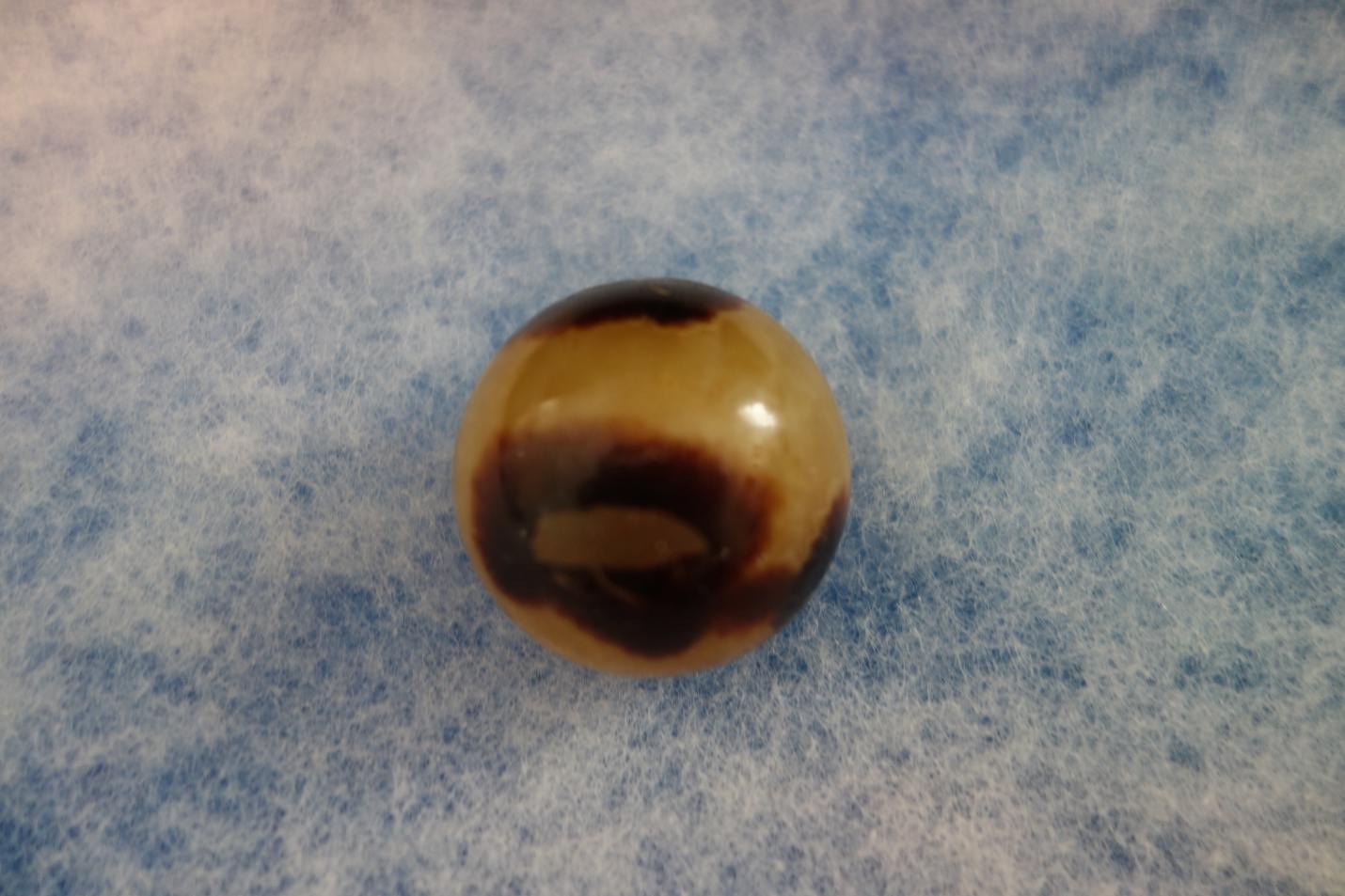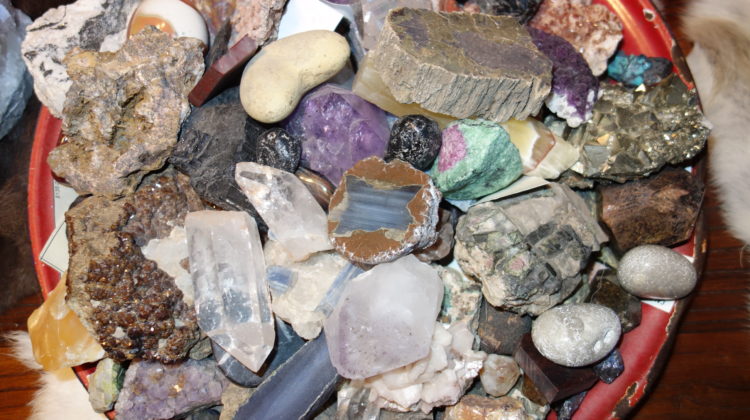
From the Collection of Mitch & Stacey Dunn
In our first post about mineral marbles we explained that we have always enjoyed collecting minerals and gemstones as well as glass marbles.
Our approach to the topic is geologic rather than metaphysical, and we defined a few scientific terms useful to any gem and mineral collector.
One Among Many
So, this time we will share a few more minerals in our collection. In our last story we pointed out that most mineral spheres sold today were never intended as toy marbles.
We started our first story with a unique Victorian infused agate which was cut and designed as a marble and it was used to play marbles. We will again start with a mineral designed as a marble which was played with.
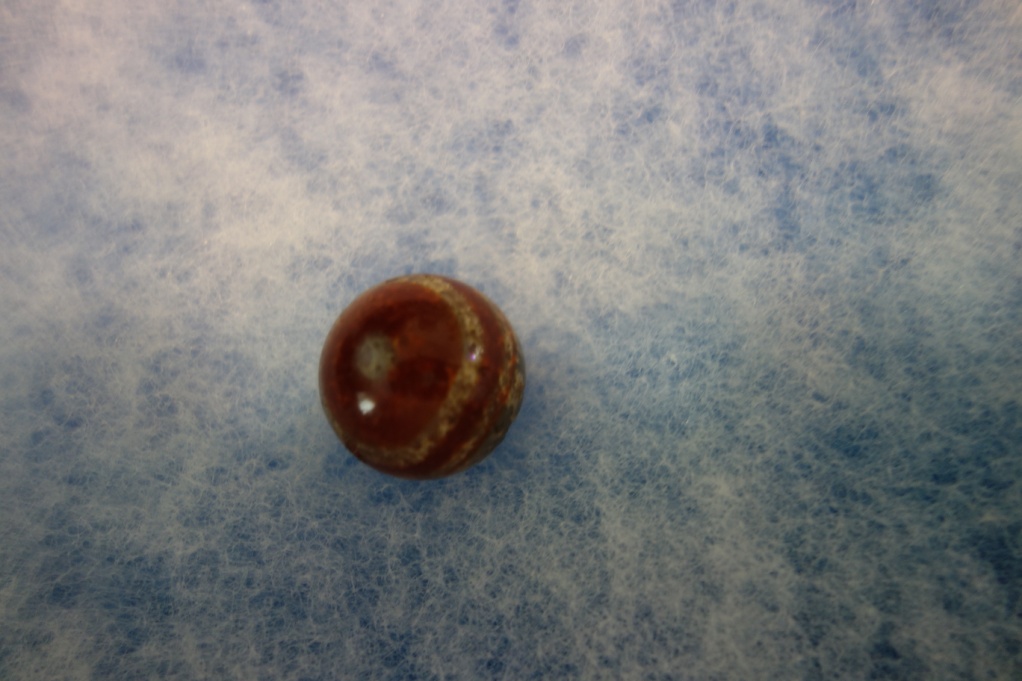
Bullseye Red Carnelian
This is a 23/32” natural and undyed gemstone handmade as a marble. It is impossible to either date the marble or determine where it was made. Paul Baumann, in Collecting Antique Marbles, 4th Ed. (page 18) tells us that the production of agate marbles was mentioned in Idar and Oberstein villages in Germany as early as 1775.
Agate marble production peaked in Germany between 1860 – 1914, but we have seen reports of the advertised sale of inexpensive German agates in America as late as the early 1930s.
Also, gorgeous agate marbles were made at the California Agate Company which ground agates in the 1920s – 1930s. They opened in Los Angeles and later moved to Huntington Park in southeastern Los Angeles County.[1]
Running the Table
“Aggies”, whether domestic or foreign, could be killers for glass, clay, and China marbles. “… were so deadly accurate as the shooter that they were banned from many games and tournaments.”[2] By contrast, clay taws were used in sanctioned marble tournaments until well into the 1920s.
There were all sorts of dust-ups in schoolyards and country lanes when “Dead Eye Pete” either knocked everyone’s marbles out of the ring on the first shot or shattered the glassies into bits. All these years later we still often find spalls splintered from glass marbles.
Our old aggie taw has some bumps and bruises, and, for some odd reason one pole looks like it has been exposed to high heat. Practically, quartz crystals won’t melt or burn. So the bumpy discoloration on our marble is a mystery. If the entire marble had been in a house or barn fire the whole thing could be discolored if the heat was intense. We have no idea how only one part was discolored.
Carry on Regardless!
Aggies and carnelians like those in our collection were also rough on the shooter’s appendages. When we were writing Chapter Six, “To Have and To Hold…” in our book The Secret Life of Marbles (page 137) we spoke with an older gentleman who told us that as a child he loved to play ringer with California Agates. He gave no quarter and the aggies were equally merciless to his thumb nails.
He said that after a while the thumbnail on his shooting hand would fall off. He simply shot with the other hand while the thumb healed. When either thumb healed he would go right back in with his aggie!
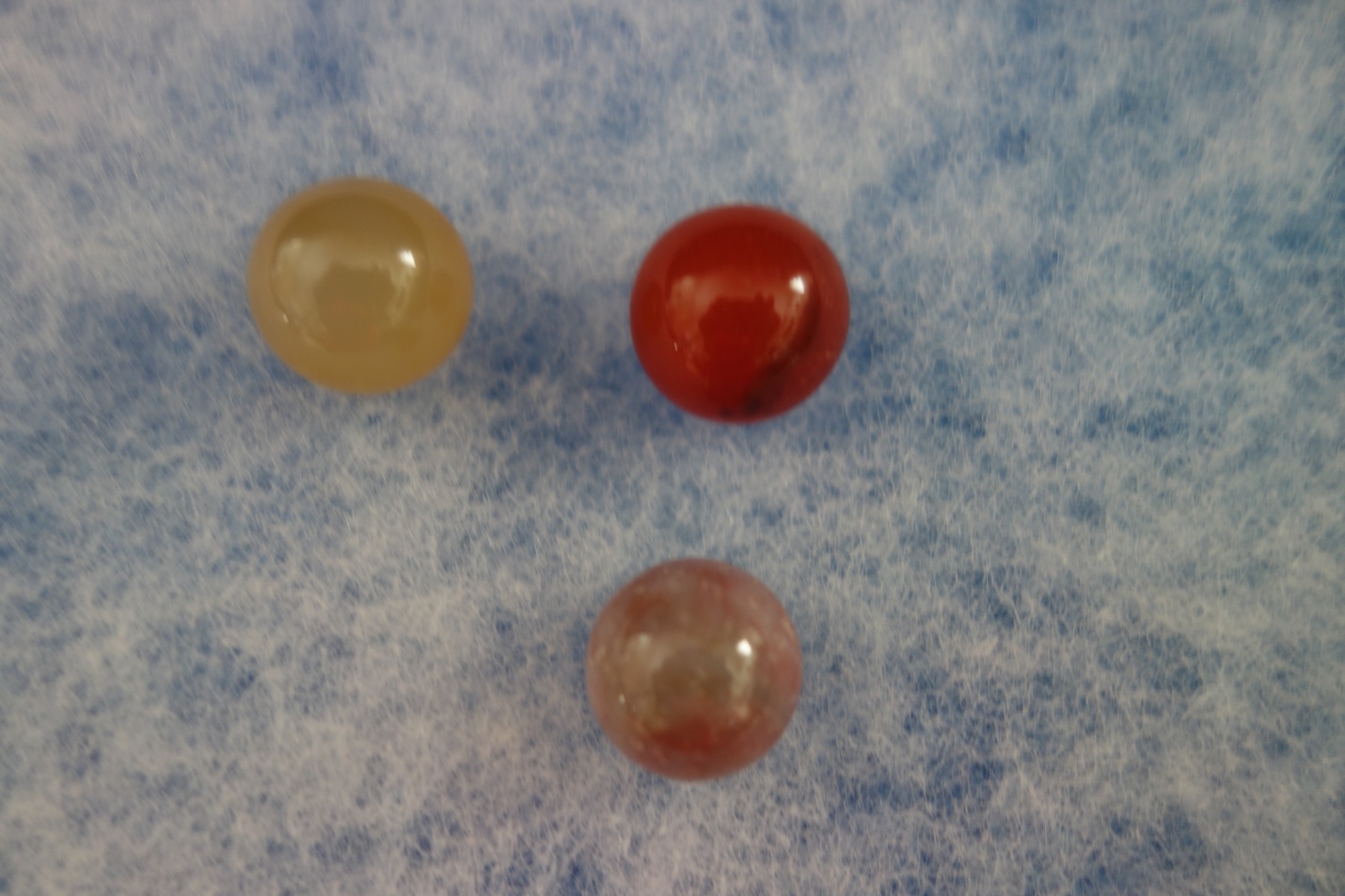
Contemporary Agates
Compare the agates in the photograph above with the earlier one of our antique warrior. There is hardly any comparison at all. While the modern agates are marble-size they were not made for play. Still, we hope some child somewhere will give it a go!
In our first mineral story we mentioned that it you want to collect minerals and gemstones then a great place to start your collection or to add to it is at a local rock and mineral show.
For example, we bought these contemporary agates in June 2019 at the Rock Fest which is held each year at the Tellus Science Museum[3] in Cartersville, Georgia.
One agate is 19/32” and it is almost purple. The amber, the more clear or translucent, and the dark cherry are all ⅝”. If you want to collect mineral orbs such as agates then you might want to focus to getting as many different colors as you can. They display beautifully.
What Is That Thing?
One of the best things about rock and mineral shows is that the sellers absolutely know which minerals they have on offer! There are 4,000 naturally occurring minerals on earth, and if you buy an orb with no idea what it is, you will be in trouble unless you really don’t care and only want the color and texture for display.
But just wait until you are in dusty Nacogdoches at an estate sale. It would be 98° in the shade it there was any. You’re checking out Uncle Norman’s crystal ball. It’s the right size for your collection and its really shiny in the sun, but Aunt Maude wants $23.00 for it. Firm.
Buy it or not? Well, considering that it’s actually Natural Clear Gold Rutilated Titanium quartz valued at around $150.00, you really don’t want to pass it up! If a seller can give you some idea about the nature or colloquial (or trade name) of a gemstone you may be able to identify it. Otherwise, it can be very frustrating.
Minerals in the Rough
We really enjoy visiting the Black Market Minerals shop in Old Town, Orlando, Florida, and Myrtle Beach, South Carolina. They also have shops in Hilton Head, South Carolina, and Tempe, Arizona.
The best thing about Black Market is that the orbs are all clearly labeled and in wooden bins. Be careful: some people don’t put them back where they found them! Staff is knowledgeable and often tell you where a gemstone originated. And, to top it off, the shop carries “cheat sheets”. Neat laminated cards with a dozen or so names, corresponding pictures, and orbs of all colors. You can buy a card which you can use later.
Don’t shy away from smaller shops. For example, we had a fantastic time at the Nature’s Own in Nederland, Colorado, and we found things we had never seen before.
And, finally, don’t overlook the gold mines! We always visit the Pigeon Forge Gem Mine in Tennessee every time we are in town.[4] As a rule the minerals in their gift shops are labeled. Yes, we have panned for gold!
We have also taken a gold mine tour in Georgia and we went deep underground in a silver mine in Colorado. These tourist attractions, as well as locations where you can search for minerals such as garnets in North Carolina, generally have gift shops loaded with minerals and gemstones and very skilled staff.
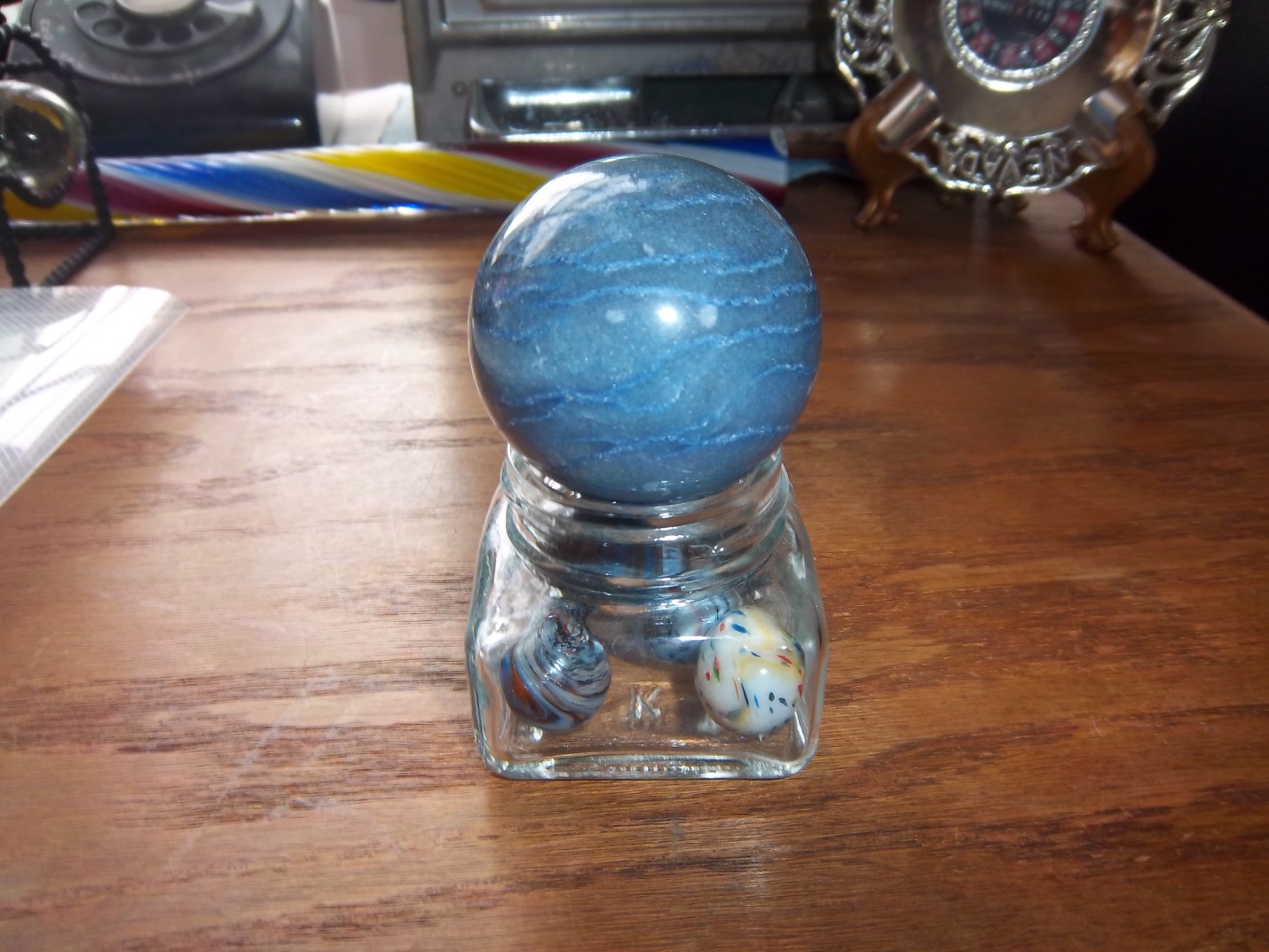
Shimmering Aventurescence
Almost all of us who collect glass marbles have a few samples of this mineral in our collection: inside our marbles!
This is a 2” example of blue aventurine. Many collectors are more familiar with green sparkles in our marbles. But did you know that aventurine also comes in brown, gray, and even yellow?
The first time we saw blue aventurine being worked into a glass marble was by a flame or torch worker on Wells Street at the Sistersville, West Virginia, Marble Festival several years ago. He gave us some raw aventurine and we wanted to find an orb for a display.
In late November in 2015 at Flea World, Auburndale, Florida, we found this orb. Now we wanted a special display for the sphere.
Fun with Minerals
In the summer of 2015 Dave McCullough ran Everglades marbles for us. We had a wonderful time and enjoyed time with Dave and friends and our visit to Pennsboro, West Virginia.
When we wanted a special display for the aventurine we thought about the Everglades run. We used a good deal of both blue and green aventurine (as well as Lutz) in the run so we decided to use an antique inkwell as a base. Then we placed some of the marbles which we made (with blue aventurine both inside and on the surface) inside the old inkwell.
Finally, as seen in the photograph above, we placed the orb on top. Jo is remarkably creative this way, and the display was fun to plan and put together, beautiful, and it tells a story which is meaningful to us.
There is just no limit to how you can build displays for minerals. We display minerals using a driftwood base. If you are a beachcomber then you know that there are all sorts of bits and bobs which would make wonderful orb stands.
If you are good at woodcrafts then you can build boxes; if you are a digger then look for all sorts of stands in the dump!
Above all, have fun with the minerals you collect!
Aventurine Quartz
MineralMiners.Com® (https://mineralminers.com/) notes that “Blue Aventurine Quartz and Green Aventurine Quartz are actually quartzites (a rock, not a mineral) composed essentially of interlocking macrocrystalline quartz grains with disseminated grains of other color imparting minerals.”
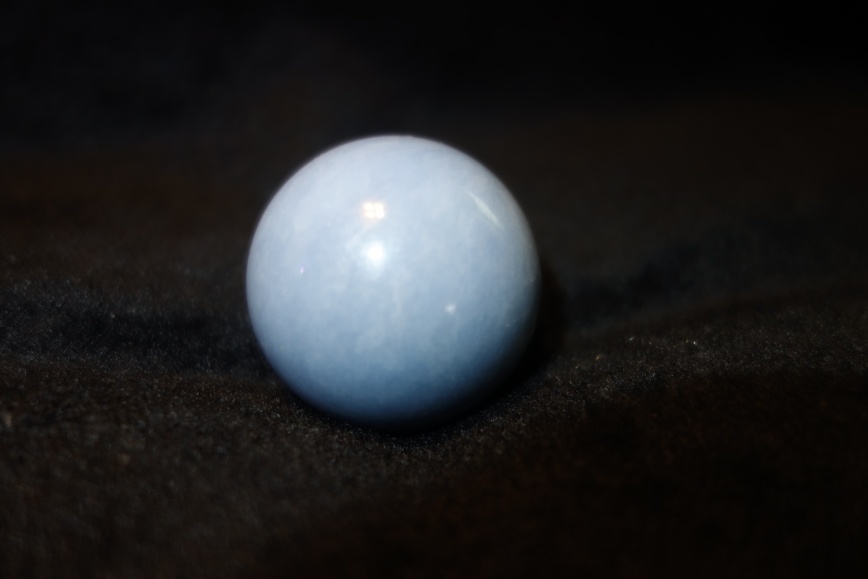
The Angel Stone
Our sample of Angelite is 1½”. In our first mineral story we mentioned the metaphysical properties often associated with minerals and gemstones. Well, we want to quote from Minedat.org on this one. “The mindat.org database is a key resource for education about rocks and minerals and their importance to society. Our powerful search tools allow both beginners and experts to find answers, consult experts, and delve deeper into a growing archive of educational articles, downloadable books and magazines, a comprehensive mineral and mining glossary – all being updated every day.”
As for Angelite: “A trade name for a semi-transparent light blue-grey fine grained Anhydrite marketed as a gem material from Peru. The local little lapidary factories in Lima made it into balls, eggs, ‘wands’, animal carvings etc. The name first appeared as a new age/metaphysical name and had various ‘powers’ attributed to it. As yet, the name has not been applied to anhydrite from any other locality.”
The High Mountains of Peru
The pale blue Angelite was discovered in Peru in 1987. It comes from the Casapalca mines in Huarochiri Province, Lima Department. As noted, Angelite is a form of Anhydrite. Anhydrite can be found in white, grey, pink, and even green. It is formed from the compression of Celestite over millions of years and it is found in Egypt, Germany, Mexico, Peru and Poland. However, the baby blue “angelic” Anhydrite is only found in Peru.
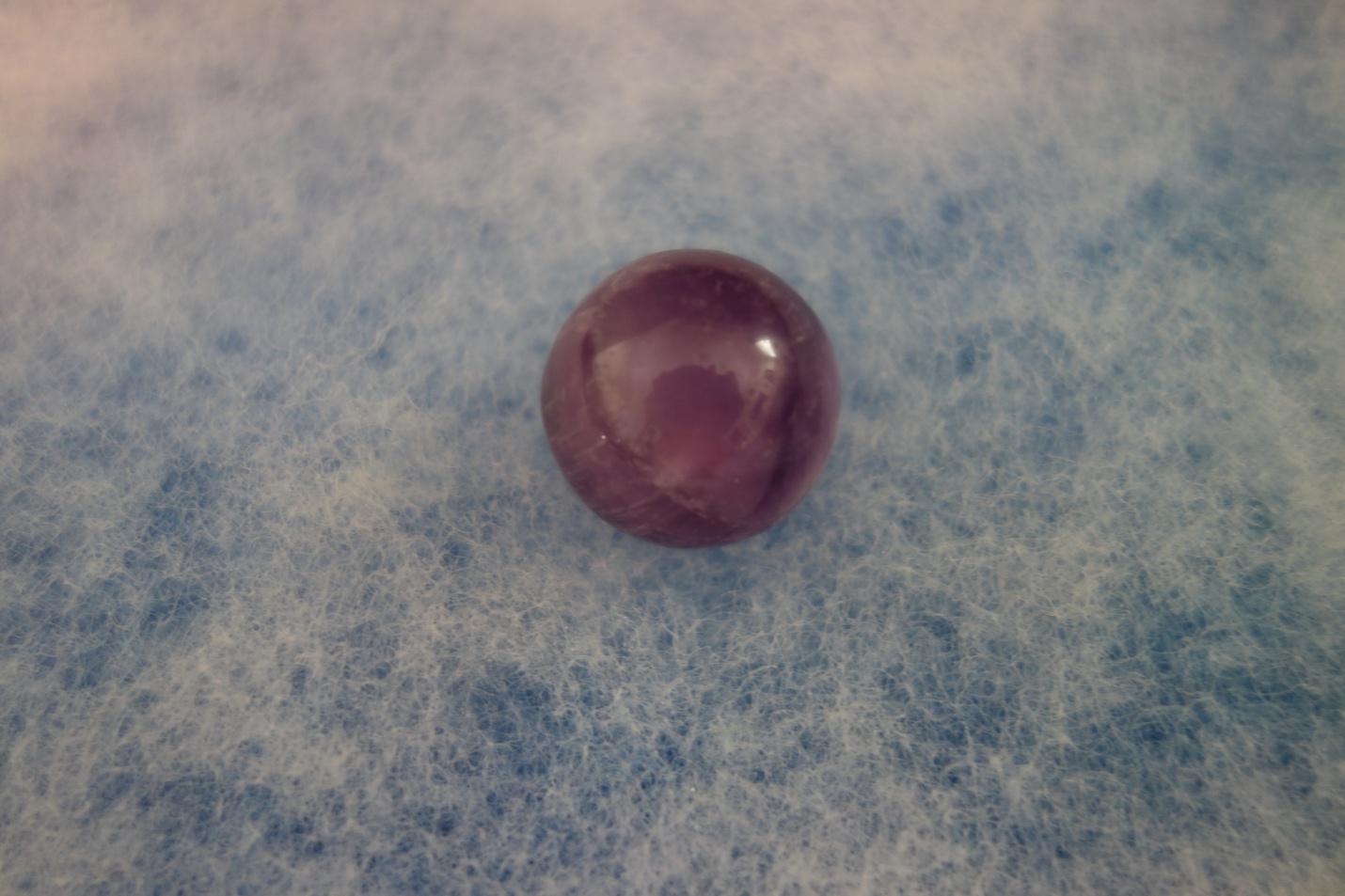
This amethyst orb is certainly the right size to be a marble. It is 13/16” and the dealer assured us that it has not been infused, but is natural. It is a gorgeous stone which looks like it is banded. In the “raw” amethyst crystals may appear in towers, as shown below.
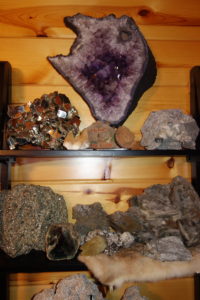
Natural Amethyst & Other Minerals from the Collection of Mitchel & Stacey Dunn
We are confident that it is natural because we bought the orb from a reputable dealer in August 2019 at the Dalton Georgia Gem and Mineral Jewelry Show.
When collecting minerals you want to be careful whom you buy from if you are investing a good deal into a sample. Keep a “cheat sheet” like the card from Black Market Minerals and check it against the sample on offer. Ask if the dealer is using a trade name for the mineral or rock. Have fun!
These little amethyst marbles cost only about $10.00 or less. They are all tones of purple and they display very well and look especially nice with a few amethyst crystals scattered about. You can buy with assurance at rock and gem shows and from reputable dealers in antique shops and at many flea markets.
Amethyst usually is a transparent variety of quartz that comes in shades of purple. Some translucent to opaque amethyst is also found and the purplish zones alternate with white or grayish areas. Color zonation can be very intense in transparent, translucent and opaque varieties.
Most of the amethyst that is used in the gem trade now comes from Brazil. Historically, the Ural Mountains in Russia produced many fine amethysts and thousands were acquired by Catherine the Great. The most desired hues ranged from deep purplish-red to purple-red and these stones were called Uralian or Siberian Amethyst, terms that are now color grades rather than source areas”[5].
A Nodule of What?
In September 2013 Larry’s sister Lynn Howell, who also collects rocks and mineral marbles, found this 1¼” sample in The Rock Shop, Gatlinburg, Tennessee.[6] It is a Septarian Nodule.
Great Balls of Mud!
The small card which came with the nodule reads: “Septarian geodes formed 100 million years ago when the Gulf of Mexico reached up to southern Utah. When sea life died, it became trapped in sediments and formed mudballs. As the sea receded, the mudballs dried and cracked in the sun, the sea returned and calcium from newly decomposing shells eventually seeped into the cracks and recrystalized as calcite (yellow), the thin brown wall is aragonite [ours is formed into patches] and the gray exterior is bentonite clay. The name Septarian comes from the Latin ‘Septum’, meaning dividing wall.”[7]
Well, mudballs! These nodules are an example of a wonderful phenomenon in mineral collecting. New things pop up all the time!
One month in mineral shops you will find Chalcedony Nodules from Morocco; then Mookiate; then Rhodocosite; then Howlite. It can be great fun just seeing what’s next! Rock crystal, amethyst, banded agate, and many others never seem to go out of style.
But explorers worldwide are constantly searching for new minerals and, as we mentioned in the first Mineral Story Fun With Mineral Marbles, they are re-visiting the tailings from old mines looking for minerals to collect and turn into orbs and all sorts of stone products. Remember, some of these mines have been abandoned for generations.
¿Donde esta la mina?
A mineral collection can be a wonderful adjunct to a glass, stone, and China marble collection. It lends itself to creativity in building displays, deciding which gemstones and minerals you want to add to the collection, and, above all for us, meeting the people who sell the stones. There are flea markets to explore, rock and gem shows to attend, rock, gem, and crystal shops to visit, local mineral clubs to check out, and if you check you will find that many of your favorite antique shops also sell a few rock and gem orbs. Have fun!

- The single best report that we know of about this venture is the PDF “California Agate Company” which has the notation “Special thanks to “Steph” of marbleconnection.com for historical information and selected images.” The images are gorgeous. You can find the paper at https://www.marblecollecting.com/ You will need to subscribe at marbleconnection, but it is a simple process and well worth the time. There is another story there called California Agates — Marble Mystery Another place to find gorgeous images of both dyed and natural agates is Stanley A. Block’s Marbles Beyond Glass starting on page 9. ↑
- “California Agate Company” PDF. ↑
- Click the “Explore” button at https://tellusmuseum.org/explore/exhibits/ (5/3/2023) then “Exhibits” to visit the Weinman Mineral Gallery. Then enjoy the slide show which includes a collection of mineral orbs. The Museum also has a permanent assortment of high quality orbs (and staff who know what they are!) in the giftshop. ↑
- https://smokymountains.com/pigeon-forge/things-to-do/pigeon-forge-gem-mine/ 5/3/2023 ↑
- https://snr.unl.edu/data/geologysoils/birthstones/amethyst.aspx 5/3/2023 ↑
- Unfortunately, we believe that this wonderful little shop is now closed. ↑
- http://www.therockshed.com/septarians.html 10/7/2013 ↑

